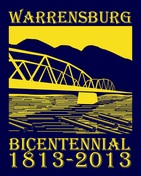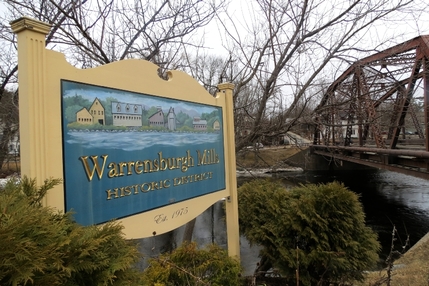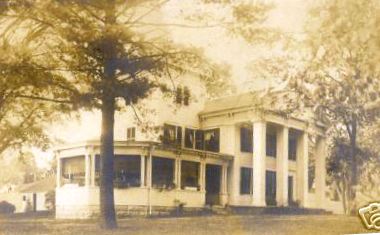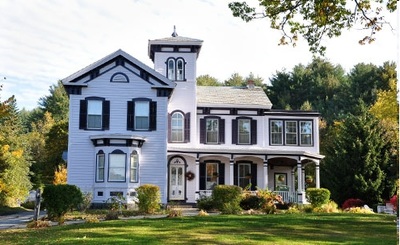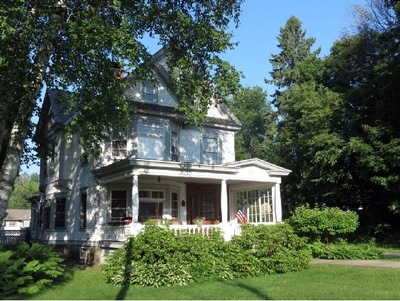|
The Hamlet of Warrensburgh Historic District is a component in the multiple property submission, Historic and Architectural Resources in the hamlet of Warrensburg. It was identified as a result of a comprehensive historic resources survey, Intensive Level Survey of Historic and Architectural Resources in the Hamlet of Warrensburgh, Warren County, New York (1996). Subsequently, with assistance from the New York State Office of Parks, Recreation and Historic Preservation Field Services Bureau, the Hamlet of Warrensburgh Historic District was identified as meeting the criteria for listing on the State and National Registers of Historic Places.
|
Narrative Statement of Significance

The significance of the Hamlet of Warrensburgh Historic District is clearly communicated by its cohesive collection of buildings and structures that span a period of over 150 years and provide a comprehensive representation of architectural styles and historic building associations and functions, which encapsulate many of the historic themes central to the development of New York State’s Adirondack region.
The historic district straddles the Schroon River and encompasses nearly the entire historic core of the hamlet. It includes numerous largely intact examples of nineteenth to mid-twentieth century’s domestic, commercial, civic, industrial and religious architecture, as well as bridges, a dam and a small centralized village park with a bandstand. Stylistically, a range of vernacular to high-style interpretations are represented in the district with the latter comprising only approx-irately 15% f the total resource count. The remainder of resources in the historic district are modest vernacular interpretations of mid-nineteenth and early twentieth century’s architectural styles which reflect the large working class community in this historic industrial hamlet.
The historic district straddles the Schroon River and encompasses nearly the entire historic core of the hamlet. It includes numerous largely intact examples of nineteenth to mid-twentieth century’s domestic, commercial, civic, industrial and religious architecture, as well as bridges, a dam and a small centralized village park with a bandstand. Stylistically, a range of vernacular to high-style interpretations are represented in the district with the latter comprising only approx-irately 15% f the total resource count. The remainder of resources in the historic district are modest vernacular interpretations of mid-nineteenth and early twentieth century’s architectural styles which reflect the large working class community in this historic industrial hamlet.
History
This physical division directed the hamlet’s Industrial, commercial, residential and socio-political development throughout the nineteenth and twentieth centuries. This physical division directed the hamlet’s Industrial, commercial, residential and socio-political development throughout the nineteenth and twentieth centuries. The result being a busy Main Street on the north side of the river lined with a mixture of mid-to-late nineteenth century commercial, civic, religious and large-scale residential properties; while on the south side of the river, there was a strong industrial presence with a number of large mills, associated industrial buildings, worker’s housing and small-scale vernacular residences.
Historic Mills (SOUTH OF SCHROON RIVER)
Throughout the nineteenth century, the sawmills, gristmills, carding and planing mills of Woodward, Griffing and Emerson, Burhans, Gray & Company, A. Burdick, G.T. Lewis, et al. provided the backbone of Warrensburgh’s economy.
|
Throughout the nineteenth century, the sawmills, gristmills, carding and planing mills of Woodward, Griffing and Emerson, Burhans, Gray & Company, A. Burdick, G.T. Lewis, et al. provided the backbone of Warrensburgh’s economy. However, by the mid-1900’s, this industrial base succumbed to the economic pressures of expanding national markets resulting in the loss of a number of industrial buildings. Despite this, an intact group of imposing mills and associated storage and office buildings still remain on the south side of the Schroon River, which continue to identify this part of the hamlet as the heart of Warrensburgh’s industrial center.
|
|
Significant historic resources within the historic district that reflect this early industrial base in Warrensburgh include two late-nineteenth century, massive industrial buildings located across the street from one another at 89 River Street* (presently Lizzie Keays) and 86 River Street.* These buildings, which were both involved in the manufacture of shirts and shirtwaists and originally connected by an overpass, were built by the Empire Shirt Company and J.P. Bauman & Sons. The oldest industrial building in the historic district is at 100 River Street* (presently a restaurant called The Gristmill). Built in 1824 by Dudley Farlin to replace an earlier (1806) mill on the site, the building was purchased and improved during the mid-nineteenth century by Burhans, Gray & Company, eventually producing 15 tons of produce in a 12-hour period.
|
|
Two other notable industrial buildings from the turn-of-the-century, which are located near what was the terminus of the railroad spur (no longer extant) and used for storage and shipping are the large, distinctive “Coal Pocket” (burned down in 2011) at 99 River Street* used for the storage of coal brought in by rail for the mills and manufactories along River Street,as well as area residences and the massive, grain/feed storage and shipping building of T.J. Smith & Son Company at 101 River Street*. These buildings recall through their massing, design and layout, the importance local industry and rail transportation held in the historic development of Warrensburgh.
|
|
In addition to the large industrial buildings on the south side of the river, there are numerous historically significant, non-industrial buildings that contribute to the cohesiveness of the historic industry-related community on the south side of the river. The small, residential-looking Greek Revival/Italianate vernacular building at 91 River Street* was the office and store for the A.C. Emerson Company; whose large lumber mill (no longer extant) was located directly across River Street. The commercial storefront buildings at 106,* 134* and 215 River Street, provided goods and services to the industry-related community on the south side of the river. And the numerous intact and significant examples of vernacular, wood frame, mid-late nineteenth century workers’ houses and other modest residences located in close proximity to the various mills and manufactories that were once active in this vicinity, clearly reflect the size and vitality of the historic local industry and its profound effect on the growth and development of Warrensburgh |
Architectural Examples Noteworthy architectural examples that reflect the individual prosperity of their original owners and contribute to the overall upscale historic character of the neighborhood on the north side of the Schroon River include:
|
|
The remaining residential building stock on the north side of the river is comprised primarily of late-nineteenth/early-twentieth century’s modest single family houses, such as:
that reflect vernacular interpretations of popular Victorian styles. Concentrations of these residences on the streets radiating out from Main Street reflect the significant development that occurred on the north side of the Schroon River during the latter decades of the nineteenth century. Examples of earlier modest vernacular residential architecture, such as the Greek Revival residences with Victorian modifications at 3882 and 3888 Main Street are primarily located closer to the commercial core of the hamlet. |
|
The historic and current commercial core of the hamlet is clearly identified by the cluster of distinguished historic properties at the intersection of Main, Elm and Hudson streets. At the point of the intersection is the Floyd Bennett Park and Bandstand (1930-31), a small triangular green with a Colonial Revival octagon bandstand on a raised brick base, built to commemorate Floyd Bennett, a Warrensburgh native, who piloted Commander Richard Byrd in the first flight to the North Pole. Facing the park at 3873 Main Street is the Woodward Block, a significant, mid-nineteenth century, large, stone, Mansard-roofed commercial building. Across the street at 3 Hudson Street*, is the distinguished temple-front Merrill Magee Inn** (1831-1855), now operated as a restaurant and inn. Next to the Merrill Magee Inn is the Wills Block at 7 Hudson Street, which is a distinguished c.l865 stone and frame commercial building. Across from that is another notable commercial building that fills in the “V” behind the Woodward Block and has storefronts on both Main (#3875) and Hudson streets. The continuing vitality and commercial development along Main Street into the twentieth century is evidenced by the large, c.l927 neoclassical bank building at 3853 Main Street.
|
Churches
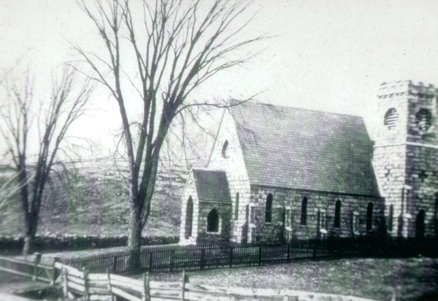
Establishment of the hamlet’s historic religious and civic buildings also occurred on the north side of the Schroon River. The churches of three denominations - Episcopal, Methodist and Presbyterian - are located within the historic district. The .United Presbyterian Church at 4 Stewart Farrar Street, built in 1840, is the oldest. Built by Joseph Woodward in a Gothic Revival design, the church was later modified with Queen Anne detailing. The First Methodist Church at 3890 Main Street, a modest vernacular 1904 frame building (now vinyl sided) with a side tower, is the third church building on its site and home to the earliest organized religious group in the hamlet. Organized in 1796, the Methodists first held religious meetings in the “upper village” schoolhouse. In 1802, they built the first small church on the site of the present day church. That building was replaced in 1840 by another, which was eventually moved to 49 King Street and converted to a residence. The Episcopal Church of the Holy Cross at 3764 Main Street (discontiguous portion of the district), built in 1864, and its attached rectory and parish house, built in 1886, provide excellent examples of Gothic Revival ecclesiastical architecture executed in stone. The church was constructed at a cost of $3,000 and was financed by the Burhans and Griffing families, who were among Warrensburg’s most prosperous local industrialists. The Richards sisters (who financed the construction of the Richards Library in 1900) and Henry Griffing raised most of the funds required to construct the rectory and parish house. Prior to the construction of the Richards Library on Elm Street, the parish hall functioned as a community library.
Civic Buildings
Civic buildings that were associated with nineteenth century development of the hamlet no longer exist within the historic district.
All three historic civic buildings in the district, the Richards Library at 36 Elm Street, the original Odd Fellows Hall (now the VFW and Museum of Local History) at 3754 Main Street (discontiguous portion of the district), and the Warrensburgh Central School at 1James Street, represent the early-to-mid twentieth century expansion of the hamlet on the north side of the river. The Richards Library, a stone building built in 1900 sisters by Mary Richards Kellogg and Clara Richards, is an outstanding example of Colonial Revival civic architecture. The original Odd Fellows (I.O.O.F.) Hall at 3754 Main Street, built in 1926, is a concrete block utilitarian building designed in the typical meeting house/grange form. Originally located in the Wills Block building at 7 Hudson Street, the I.O.O.F. Lodge #388 was established in Warrensburgh in 1881.
All three historic civic buildings in the district, the Richards Library at 36 Elm Street, the original Odd Fellows Hall (now the VFW and Museum of Local History) at 3754 Main Street (discontiguous portion of the district), and the Warrensburgh Central School at 1James Street, represent the early-to-mid twentieth century expansion of the hamlet on the north side of the river. The Richards Library, a stone building built in 1900 sisters by Mary Richards Kellogg and Clara Richards, is an outstanding example of Colonial Revival civic architecture. The original Odd Fellows (I.O.O.F.) Hall at 3754 Main Street, built in 1926, is a concrete block utilitarian building designed in the typical meeting house/grange form. Originally located in the Wills Block building at 7 Hudson Street, the I.O.O.F. Lodge #388 was established in Warrensburgh in 1881.
|
The Warrensburgh Central School, built in 1942, is a remarkably intact and outstanding example of Georgian Revival civic architecture. Also, as its predecessors, the Warrensburgh Academy (1854), the Warrensburgh Union Free School (1899), and the Warrensburgh High School, no longer remain. It is the only extant historic resource associated with the development of educational opportunity in the hamlet. |
Camps
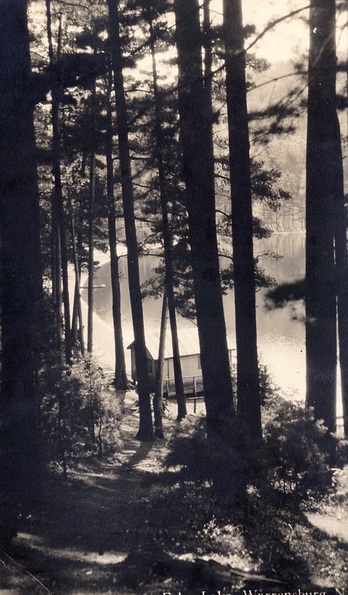
During the latter part of the nineteenth century and into the twentieth century, as local industry succumbed to the economic pressures of expanding national markets, the recreation and tourism industry in the Adirondack Region emerged as central to the region’s economy.
This shift in the region’s economic base is evidenced in the hamlet of Warrensburgh by extant recreation-related resources in the form of private cabins and camps, as well as enclaves of buildings associated with resort and summer camp business. Within the historic district this development occurred primarily north of the Schroon River. Numerous small, seasonal cabins are scattered throughout the district with. a cluster located near the Corner of Hudson Street and Third Avenue (27 & 29 Third Avenue, and 4 & 6 Park Street) that were associated with Ashe’s Hotel on Hudson Street. However, the largest single resource associated with this theme is the 135-acre Camp Echo Lake property located on Echo Lake at the north end of Hudson Street. Established during the first quarter of the twentieth century as a camp for young adults, it. was reorganized in the late 1930s to become a children’s camp and in 1946, a neighboring enclave of cabins south of Fish Hatchery Road was added to the property. Today, Camp Echo Lake, with its numerous cabins, administrative buildings, lodges and recreation-related landscape features, is still an active, vital seasonal camp for children, which retains a substantial degree of historic integrity and clearly communicates a sense of the historic theme of recreation and tourism, and particularly the importance summer camps have played in the historic development of North Country communities like Warrensburgh.
Now, in the beginning of the twenty-first century, The Hamlet of Warrensburgh Historic District is comprised of a wide assortment of intact historic resources that embody the physical and associative attributes of various development themes that molded the character of the hamlet and, taken together, evoke a rich sense of the hamlet’s cultural heritage and chronicle its historic development.
This shift in the region’s economic base is evidenced in the hamlet of Warrensburgh by extant recreation-related resources in the form of private cabins and camps, as well as enclaves of buildings associated with resort and summer camp business. Within the historic district this development occurred primarily north of the Schroon River. Numerous small, seasonal cabins are scattered throughout the district with. a cluster located near the Corner of Hudson Street and Third Avenue (27 & 29 Third Avenue, and 4 & 6 Park Street) that were associated with Ashe’s Hotel on Hudson Street. However, the largest single resource associated with this theme is the 135-acre Camp Echo Lake property located on Echo Lake at the north end of Hudson Street. Established during the first quarter of the twentieth century as a camp for young adults, it. was reorganized in the late 1930s to become a children’s camp and in 1946, a neighboring enclave of cabins south of Fish Hatchery Road was added to the property. Today, Camp Echo Lake, with its numerous cabins, administrative buildings, lodges and recreation-related landscape features, is still an active, vital seasonal camp for children, which retains a substantial degree of historic integrity and clearly communicates a sense of the historic theme of recreation and tourism, and particularly the importance summer camps have played in the historic development of North Country communities like Warrensburgh.
Now, in the beginning of the twenty-first century, The Hamlet of Warrensburgh Historic District is comprised of a wide assortment of intact historic resources that embody the physical and associative attributes of various development themes that molded the character of the hamlet and, taken together, evoke a rich sense of the hamlet’s cultural heritage and chronicle its historic development.
*Indicates properties previously listed on the National Register of Historic Places as part of the Warrensburg Mills Historic District
**Indicates property previously individually listed on the National Register of Historic Places
**Indicates property previously individually listed on the National Register of Historic Places

